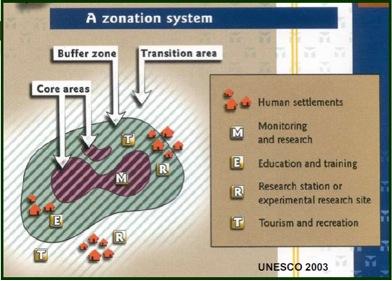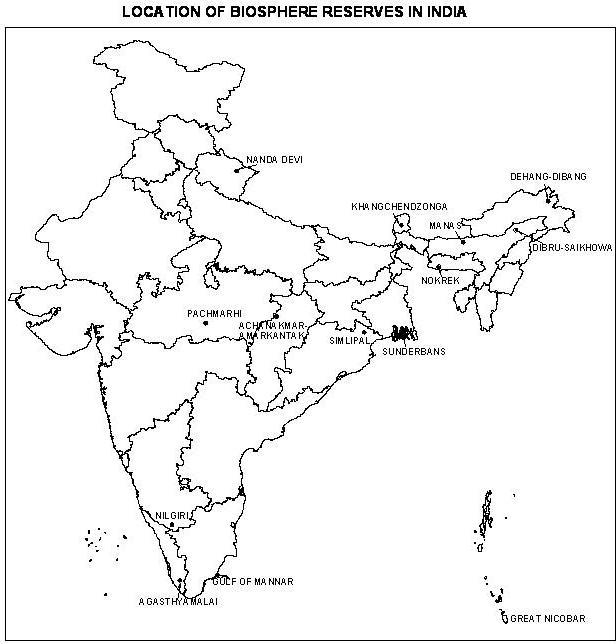Biosphere reserves are areas of terrestrial and coastal or marine ecosystems or its amalgamation. The biosphere reserve network was launched in 1971 by UNESCO, two years after the initiation of MAB- Man and the biosphere program. The Government of India established 18 biospheres in the country (categories generally relating to IUCN Category V Protected areas).
The first biosphere reserve of the world was established in 1979. There are 701 Biosphere reserves across 124 countries in the world which also include 21 transboundary sites.
Distribution of the Biosphere Reserves across the World are as follows:
- 79 sites in 29 countries in Africa
- 33 sites in 12 countries in the Arab States
- 157 sites in 24 countries in Asia and the Pacific
- 302 sites in 38 countries in Europe and North America
- 130 sites in 21 countries in Latin America and the Caribbean.
Functions of a Biosphere Reserve
Each biosphere reserve is supposed to fulfill three harmonizing functions:
- Conservation function: to conserve genetic resources, species, ecosystems, and landscapes
- Development function: to promote sustainable human and economic development.
- Logistic support function: to provide support for research and analyzing the issues of conservation and sustainable development.
Three zones of the Biosphere

Biosphere reserves have three unified zones that aim to fulfill three harmonizing and mutually reinforcing functions:
- The core area: It involves an entirely secured and protected ecosystem that contributes to the preservation of landscapes, ecosystems, species and genetic variation.
- The buffer zone: It encompasses or adjoins the core areas. It is utilized for activities compatible with sound ecological practices that can fortify scientific research, monitoring, training, and education.
- The transition area: It is the part of the reserve where the greatest activity is permitted to promote economic and human development that is sustainable.
UNESCO Protected Biosphere Reserves
The World Network of Biosphere Reserves (WNBR) covers globally chosen protected areas. It consists of a vibrant and interactive network of sites of distinction. It promotes the harmonious assimilation of people and nature for sustainable development in different ways. If one country declares one area as a biosphere reserve, it can nominate the same to under the UNESCO’s Man and Biosphere (MAB) Programme. If UNESCO accepts the proposal of the government, the biosphere reserve will enter into the World Network of Biosphere Reserves (WNBR).
The UNESCO Protected Biosphere Reserves list in India are given below:
| YEAR | NAME | STATES |
| 2001 | Sundarbans Biosphere Reserve | West Bengal |
| 2009 | Simlipal Biosphere Reserve | Odisha |
| 2009 | Pachmarhi Biosphere Reserve | Madhya Pradesh |
| 2009 | Nokrek Biosphere Reserve | Meghalaya |
| 2000 | Nilgiri Biosphere Reserve | Tamil Nadu |
| 2004 | Nanda Devi Biosphere Reserve | Uttarakhand |
| 2001 | Gulf of Mannar Biosphere Reserve | Tamil Nadu |
| 2013 | Great Nicobar Biosphere Reserve | Great Nicobar |
| 2012 | Achanakmar-Amarkantak Biosphere Reserve | Chhattisgarh |
| 2016 | Agasthyamala Biosphere Reserve | Kerala and Tamil Nadu |
| 2018 | Kanchenjunga Biosphere Reserve | Part of North and West Sikkim districts |
UNESCO Protected Biosphere Reserves in India
Biosphere reserves are announced by the state or central governments by notification. The Governments can nominate them under the UNESCO’s Man and Biosphere (MAB) Programme after its establishment as a biosphere reserve. There are 18 biosphere reserves in India.
| No. | Name of Biosphere Reserve | Year of Notification | Location (States) |
| 1 | Nilgiri | 1986 | Part of Wayanad, Nagarhole, Bandipur and Madumalai, Nilambur, Silent Valley, and Siruvani hills (Tamil Nadu, Kerala and Karnataka). |
| 2 | Nanda Devi | 1988 | Part of Chamoli, Pithoragarh, and Bageshwar districts (Uttarakhand). |
| 3 | Nokrek | 1988 | Part of Garo Hills (Meghalaya). |
| 4 | Great Nicobar | 1989 | Southernmost islands of Andaman And Nicobar (A&N Islands). |
| 5 | Gulf of Mannar | 1989 | The Indian part of the Gulf of Mannar between India and Sri Lanka (Tamil Nadu). |
| 6 | Manas | 1989 | Part of Kokrajhar, Bongaigaon, Barpeta, Nalbari, Kamprup, and Darang districts (Assam). |
| 7 | Sunderbans | 1989 | Part of the delta of Ganges and Brahmaputra river system (West Bengal). |
| 8 | Simlipal | 1994 | Part of the Mayurbhanj district (Orissa). |
| 9 | Dibru-Saikhowa | 1997 | Part of Dibrugarh and Tinsukia Districts (Assam). |
| 10 | Dehang-Dibang | 1998 | Part of Siang and Dibang Valley in Arunachal Pradesh. |
| 11 | Pachmarhi | 1999 | Parts of Betul, Hoshangabad, and Chindwara districts of Madhya Pradesh. |
| 12 | Khangchendzonga | 2000 | Parts of Khangchendzonga hills and Sikkim. |
| 13 | Agasthyamalai | 2001 | Neyyar, Peppara, and Shendurney Wildlife Sanctuaries and their adjoining areas in Kerala. |
| 14 | Achanakamar – Amarkantak | 2005 | Covers parts of Anupur and Dindori districts of M.P. and parts of Bilaspur districts of Chhattishgarh State. |
| 15 | Kachchh | 2008 | Part of Kachchh, Rajkot, Surendra Nagar, and Patan Civil Districts of Gujarat State. |
| 16 | Cold Desert | 2009 | Pin Valley National Park and surroundings; Chandratal and Sarchu & Kibber Wildlife Sanctuary in Himachal Pradesh. |
| 17 | Seshachalam Hills | 2010 | Seshachalam Hill Ranges covering parts of Chittoor and Kadapa districts of Andhra Pradesh. |
| 18 | Panna | 2011 | Part of Panna and Chhattarpur districts in Madhya Pradesh. |
Biosphere reserves in India is an important static GK topic. For information on various static GK topics, check the article linked here.
Biosphere Reserves in India- Geographical Location
The various locations of Biosphere reserves in India are shown below:

Biosphere Conservation
UNESCO is promoting the peaceful integration of man and nature for sustainable development through participatory dialogue, awareness on poverty reduction and human well-being improvement, respect for cultural values, and society’s ability to cope with change.
UNESCO has developed 631 biosphere reserves in 119 countries, out of which there are 14 transboundary sites, to foster economic and sustainable development.
Frequently Asked Questions
What is the largest and the smallest Biosphere Reserve in India?
The largest Biosphere reserve in India is the Gulf of Kachchh, Gujarat and the smallest Biosphere Reserve in India is Dibru-Saikhowa in Assam.
Which is the 1st Biosphere reserve in India?
The first Biosphere Reserve in India is the Nilgiri Biosphere Reserve that is a part of Tamil Nadu, Karnataka, and Kerala.
Who declares the Biosphere reserve in India?
The Biosphere Reserves in India are declared by the State or Central Government through Nomination under the UNESCO’S Man & Biosphere (MAB) Programme.

1 comment:
Thanks for the marvelous posting! Neet entrance examination is conducted by a national testing agency. Among the students, the Neet entrance examination is considered a tough examination because of which many aspirants get demotivated in between the journey of their preparation. But, the best online Neet coaching in Patna Will provide the right guidance and support to the students and help them in being motivated throughout the preparation till they get success in the examination. After reading this article you will know about the Top NEET coaching in Patna.
We have collected information of Neet coaching in other location that will help you in cracking in neet exam:
Best neet coaching in India
Top neet coaching in hyderabad
Top neet coaching in chandigarh
Top neet coaching in Delhi
Post a Comment